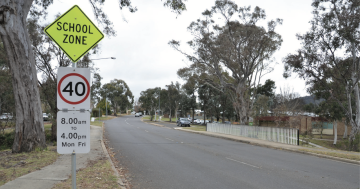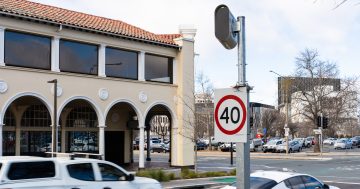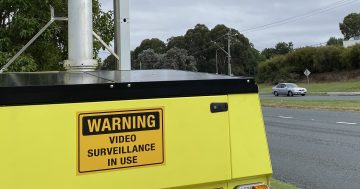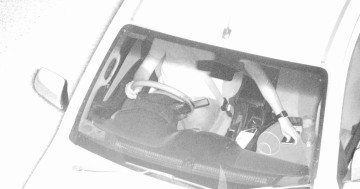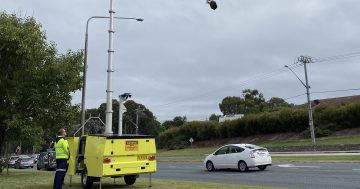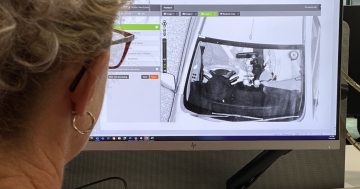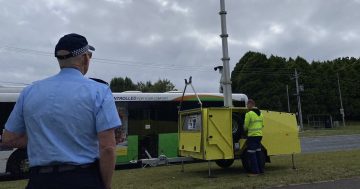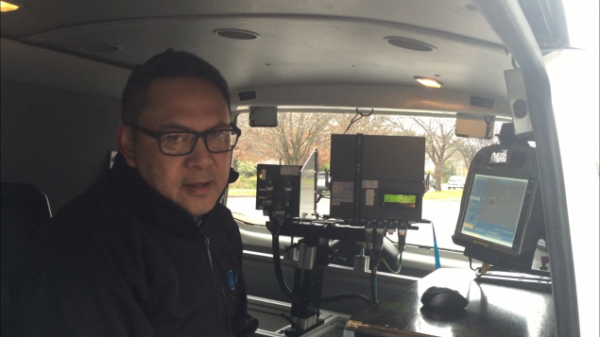
Ever wondered whether there is a real person inside those mobile speed camera vans? And whether they can catch you when you’re driving on the far side of a dual carriageway? The answers are yes, there is, and yes, they can.
RiotACT took a peek inside one of the vans when ACT Minister for Road Safety Shane Rattenbury held an event at Majura Primary last week to announce the addition of several new school zone sites for the mobile vans.
John Peti, operational supervisor at the ACT’s Traffic Camera Office, explained how the vans operate. They contain a special camera that is connected to a monitoring system that records the speed at which vehicles are approaching. If they break the speed limit, the camera takes a snapshot, capturing the licence plate so that an infringement notice can be issued. If they’re under the speed limit, no image is taken.

Mr Peti, who has worked in the camera office for around 12 years, told us that while the camera and equipment can function without a human operator once set up, there are staff inside the vans to monitor the activity and the gear.
He confirmed that you’re not necessarily going to get away with speeding just because the van is set up on the other side of the road and appears to be focused on traffic going the other way.
“It monitors up to six lanes,” Mr Peti said. “We can monitor traffic going away and coming towards us, because that defeats the purpose of us being here if we only do one side.”
He said his team was focused on trying to deter people from speeding and making them more aware about speed limits in the ACT. The operators worked closely with the AFP to meet these goals.
“So they [drivers] might see a police officer and think, oh, that’s fine, there’s no one after him, and then there’ll be a van a couple of kilometres down the road,” Mr Peti said.
“They’ll say, oh, there’s a van, there’ll be no more police after this, and there’s another police officer 2km further down the road.”
In busy areas, one van would check up to 5000 vehicles in a session, with a minimum of about 1000, depending on the traffic.
Mr Peti said parents often come up to the speed van teams operating in school zones to thank them for being there.
“I think that’s what we’re there for, to ensure that when the parents drop their children off in the morning that they’re safe, and when they come back in the afternoon … I know we can’t be there 24/7, but we try to break it up a bit so we’re there at different times,” he said.

Mr Rattenbury said the Government changed regulations last October to allow speed camera vans in school zones.
“Since then around 40 school zone sites have been tested and cleared for operation, so we’re about halfway through the program,” he said.
“The remaining 50 school sites will be assessed this year, and if suitable they will become part of our mobile camera expansion program.”
There will likely be school zones where vans can’t find a safe operating space, but most schools will be covered.
The Road Safety Minister said children were often distracted and had yet to develop road sense, which was why the 40km speed zones were so important.
“Children do not have the developmental skills to make the crucial decisions to keep them safe when crossing the road. If a child runs onto the road 30 metres ahead of you while you’re driving at 50km/h in a school zone, you won’t be able to stop in time,” Mr Rattenbury said.
The Government had issued 1177 camera-detected speeding infringements in school zones since testing began last October.
“Mobile speed cameras have been deployed to school zones over 200 times since the launch of school zone operations in October last year,” the Minister said.
“Over this period the cameras have checked the speed of over 80,000 vehicles.”
The highest speed detected was 40km/h over the posted speed limit at Radford College.
“There are people out there who are really doing the wrong thing, and I want parents to have confidence that our school zones are safe places … so they are more comfortable for their children to walk or cycle to school, knowing that the areas around schools are as safe as we can make them,” Mr Rattenbury said.
Asked about the fact that school zones operate all day in the ACT (8am to 4pm) rather than just at peak times as in NSW (from 8am till 9.30am and from 2.30pm till 4pm), the Greens MLA said this was because children were coming and going throughout the day.
“Kids are going off for excursions, they do school classes sometimes off site, children come and go at different times, if they’ve got an appointment, or their parents have had to take them somewhere and bring them back during the school day, so there are students moving around all of the time,” he said.
Other road safety measures implemented around schools in the ACT included the Active Streets Program which involves the use of 30km/h speed zones around high risk schools and dragon’s teeth road markings to further alert drivers on entry to school speed zones.
The schools which have been added to the mobile speed camera program this year are:
Early childhood centres:
Lyons Early Childhood School
Isabella Plains Early Childhood School
Primary schools:
Ainslie School
Arawang Primary School
Canberra Grammar School
Chapman Primary School
Curtin Primary School
Duffy Primary School
Fadden Primary School
Farrer Primary School
Florey Primary School
Fraser Primary School
Gold Creek School
Kaleen Primary School
Majura Primary School
Maribyrnong Primary School
Red Hill Primary School
St Jude’s Primary School
St Thomas the Apostle Primary School
Torrens Primary School
High schools:
Alfred Deakin High School
Lanyon High School
Melrose High School
St Francis Xavier High School
Colleges:
Canberra College
Daramalan College
Dickson College
Hawker College
Narrabundah College
Note: Some schools have multiple sites identified for mobile speed camera enforcement.
All mobile speed camera locations can be found at www.justice.act.gov.au












